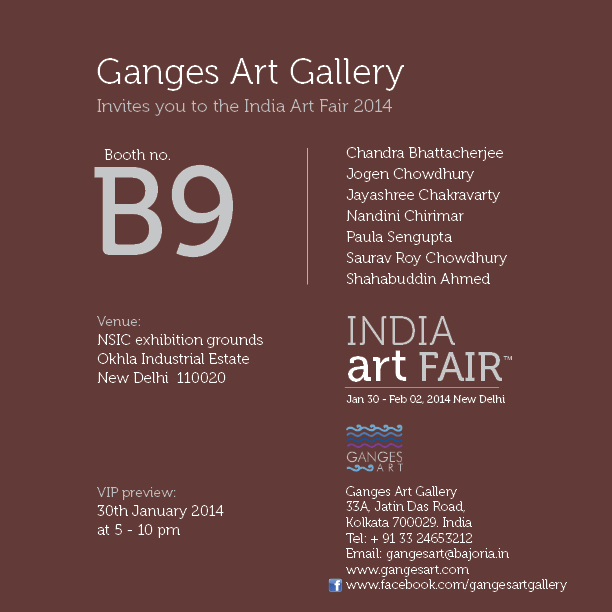
Artists to be showcased at the India Art Fair (New Delhi 2014)
Jogen Chowhdury hardly needs an introduction in the world of Indian – or for that matter, international - art. In terms of contortions and distortions, his art is seemingly simplistic, almost to a fault. But that precisely is where the appeal of his art lies – in their uncomplicated, child-like rendering, they lay bare all that is subliminal and in the domain of the subconscious; with a texturing that is so detailed and intricate, a hue-scape that is so colourful and bold, that the forms stay on with the viewer long after the first brush.
Shahabuddin today is perhaps one of those rare artists, whose works have created a mass appeal across the widest geo-cultural space possible, emerging, in the process, as an artist whose works have become the must-have for the collector-connoisseur. Reverberating with a life-force that is so throbbing one can almost reach out and feel, his works at the same time, traipse the dreamscape with equal élan. Deeply influenced by the stylistic grandeur of Bikash Bhattacharya, his paintings combine the fluidity of motion with the solidity of his unapologetically intrepid strokes.
Paula Sengupta has been a committed print-maker for a very long time now, committed not just to practicing it for her own aesthetic instincts, but also with a view to reviving forms that are now lost and forgotten, and the stories and histories surrounding their birth, evolution and subsequent loss into oblivion. These are spun with new innovative twists to create ultimate forms that are modern, contemporary and cutting-edge, in a bid to prove that all that is traditional need not essentially relapse into the domain of obsolescence.
Nandini Chirimar is an artist for whom assemblages, in different avatars, come across as being enthralling. In fact, such is the sense of awe, that she carves them in the minutes of details that are almost diagrammatic in form, cushioning them in spaces of muted pastel colours. The manner in which she scatters them out bring to her works a unique sense of chaos and order, turbulence and serenity, that makes the overall viewing experience a pleasure, to say the least.
The fact that Sourav Roychowdhury has fluidity of motion in his genes, hardly needs additional stressing – considering the fact that he is celebrated sculptor Sarbari Roychowdhury’s son. But that, thankfully, is not his only claim to fame. His sculptures are visually reminesecent of Louise Bourgeoise’s works – especially in the manner in which forms emanate and merge with various others, creating newer ones, latching onto the ones from which they emerged, remaining at the same time distinctly individualistic.
Jayashree Chakravarty says that her paintings are mostly autobiographical. "I have beenable to reach out to those who have little to do with my personal life," shepoints out, "and make them identify with my deeply felt imagery."Chakravarty's ink on paper sketches is an exercise in transition and transforming personal experience into mystical truth. She positions herself in the image of a spontaneous, instinctive woman who is a muse and eternalchild rolled into one.
Chakravarty says that her paintings, either ink on paper or oils, have the feel of a dream about them. She believes that relating to human beings of a distant country and a different culture has expanded the horizons of herimagination and forced certain pre-conceived images to change.
In her works, she uses superimposed forms, quite like the sketches that cave painters worked on before they mapped them on the walls of caves. Herimagery, because of her fluid and transparent images, reflect the presentmood of the world, which is fluid in itself. At a mere conventional andfigurative level, her works reflect the unity of man with nature.
Some motifs constantly recur in her paintings dogs, waves and serriedcrescent shapes. Influenced by post-modernist painters, each of her canvasseems to embrace the entire gamut of colors that range from blues to evenpurple.
Chakravarty has exhibited across India and Sweden and her works can be see inthe National Gallery of Modern Art, New Delhi and in Chandigarh Museum. Shewon an award in 1988 in the II Bharat Bhavan Bienniale Bhopal.
Chandra Bhattacharjee's canvases are languid and far removed from the urban world. Dusky men and women exist in an ethereal realm untouched by the madness of everyday city life, carrying out their daily chores. Bahttacharjee's compositions are influenced by the rural and tribal associations that he had an opportunity to work with; particularly the 'Santhal' tribe of Calcutta. The textural quality of his paintings is strongly reminiscent of the traditional mud walls of these villages,
smeared with cow-dung.
The colours in Bhattacharjee's paintings are at once, subdued and vibrant. Warm pinks, full-bodied blues, interspersed with blank areas, soothe the senses. He uses the technique of crosshatching (a method used more often in pencil drawings), in black, over the colour; this adds depth to his colours. Bhattacharjee's paintings tell a story, but it is a story without a beginning or an end and it flows seamlessly from the artist onto the surface of the canvas. The world of Bhattacharjee's creation is without boundaries; where humans, animals and surreal creatures coexist in harmony.
Bhattacharjee, although influenced by rural and tribal themes, has a firm academic grounding. He has studied at the Indian College of Art and Draftsmanship, Calcutta. He received a gold medal from the Rabindra Bharati University, Calcutta, in 1986. He has held several group as well as solo exhibitions of his works in Delhi, Mumbai and Calcutta.